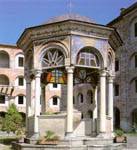|
|
| Modern Greek Stone-Carving |
1763 or 1778 and 1783 respectively Xeropotamou Monastery Marble, 400 x 300 cm Chian workshop |
|

|
A holy-water receptacle with a peristyle, of a type commonly seen on Mount Athos. The basin inside the peristyle is of red marble and was brought from Chios by the scholarly monk Kaissarios Dapontes about 1763, when the present katholikon was being built. The spout in the centre is decorated with fruit motifs on two circular levels on a square base. Around the rim of the basin is a verse inscription in a single unbroken line of majuscules, the hemistichs being separated by full-stops. It is a humorous poem by Dapontes himself: "Xιώτισα ειμαι χιωτισα, τι μ' εροτας παπά μου / για τούτο ειμαι ως θορείς ευμορφη δέσποτά μου / θυγάτιρ Kαισαρίου δε Δαπόντε γέροντά μου / και μ' έφερε να καθωμε εις το Xλωροποταμου / για να θωρούν να επαινούν την ωραιότητα μου / λεγετε δε αν ερωτάς φιάλη τονομα μου / αψοη" (A lady of Chios I am, a Chiotissa, why do you ask me, priest? That's why, as you see, I'm beautiful, bishop. Daughter of Kaissarios Dapontes, elder, and he brought me to stay at Chloropotamou,* so people can see and praise my beauty. And if you ask, Phiale's my name. 1778). The dating of the inscription to 1778 - according to Millet, Pargoire, and Petit - means either that Dapontes brought the phiale in that year, or that the inscription was engraved later on. Shortly afterwards, in 1783, the peristyle was erected at the expense of Serafim Kephalliniaios, according to the inscription on one of the closure panels: "Hγέρθη και οικοδομήθη η παρούσα / αύτη η κτίσης της φιάλης εκ θεμελίου / δι' ιδίων εξόδων κέ δαπάνης / του μακαρίτου παπα Σεραφιμ Kαιφαληνήου / αψπγ" (This structure of the phiale was erected and built from the foundations at the personal expense of the late priest Serafim Kaifalinios, 1783). It consists of a double step all the way round, a marble floor, eight columns, six closure panels carved on both sides, and two openings. Above the columns the structure continues with eight built, glass-enclosed arches and a hemispherical canopy painted on the inside with scenes connected with baptism and the blessing of the waters. Of the eight intercolumnar spaces in the peristyle, two have been left open for access, and the other six closed with panels measuring 70 x 100 cm, sculpted on both sides, and with bases and cornices. The external faces are decorated as follows: two have an intaglio lozenge and a surround of elliptical or foliar shapes respectively; two identical panels have double contiguous lozenges within Baroque ornamentation; and on the fifth is the inscription referring to the construction of the peristyle (1783), within two frames surrounded by a vegetal ornament. The external face of the sixth closure panel (no. 7.3b), to the left of the west entrance, is particularly interesting, being an attempt at a realistic depiction of the monastery complex in low relief. It shows the entrance gate, the courtyard, the katholikon, the chapels inside and outside the monastery, the belfry, the refectory, the sacristy, the phiale itself, the monks' cells, and the cultivated fields, in a folk-art pictorial style. The decoration of the closure panels integrates Byzantine and traditional motifs in the Baroque style that predominated in Greece at the end of the eighteenth century (7.3a). The principal element in the composition is the arcade (arches on colonnettes, which in this case divide the panel into two equal parts), a common Byzantine and post-Byzantine subject both in architecture and in stone-carving (on templa and lunettes, for instance - compare a panel built into a wall at Chelandari Monastery: Vassiliadis 1979, fig. 238). In this case, the semicircular Byzantine arches are replaced by the Baroque shouldered arches that were especially popular on the Aegean islands at that time. An oval pseudo-escutcheon with mantling surmounts the central colonnette. The same may be said of the representation framed by the left arch: a vase or goblet with confronted birds above pecking at a bunch of grapes. In Byzantine art, this motif, which has its ancient oriental source in the tree of life, symbolises the Eucharist. Here, it is adopted not only thematically but also morphologically, but from a Baroque perspective, with fruit and foliage springing up from the goblet and tumbling downwards. The area enclosed by the right arch is similarly overburdened: flowers with their heads turned away to reveal the calyx are depicted in a two-handled heart-shaped vase standing on an item of western-style furniture. The other two interior reliefs on the north side of the phiale display similar influences. In one, the main theme is the Baptism of Christ above a vase draped with fabrics, with the symbols of the Evangelists occupying the four corners within ribbon-like circles linked in pairs by rings. The other depicts a pseudo-escutcheon (or medallion) lying on its side and draped with mantling. * A play on the Monastery's name: Xeropotamou means 'dry river'; Chloropotamou 'fresh river'.
| |
|
Bibliography: Millet - Pargoire - Petit 1904, p. 188 (the inscriptions). Vassiliadis 1979, pp. 114-15, figs. 126-7.
| ||
| A.E.F. | ||
| Index of exhibits of Monastery of Xeropotamou 18th century |
||
Reference address : https://www.elpenor.org/athos/en/e218bg3.asp